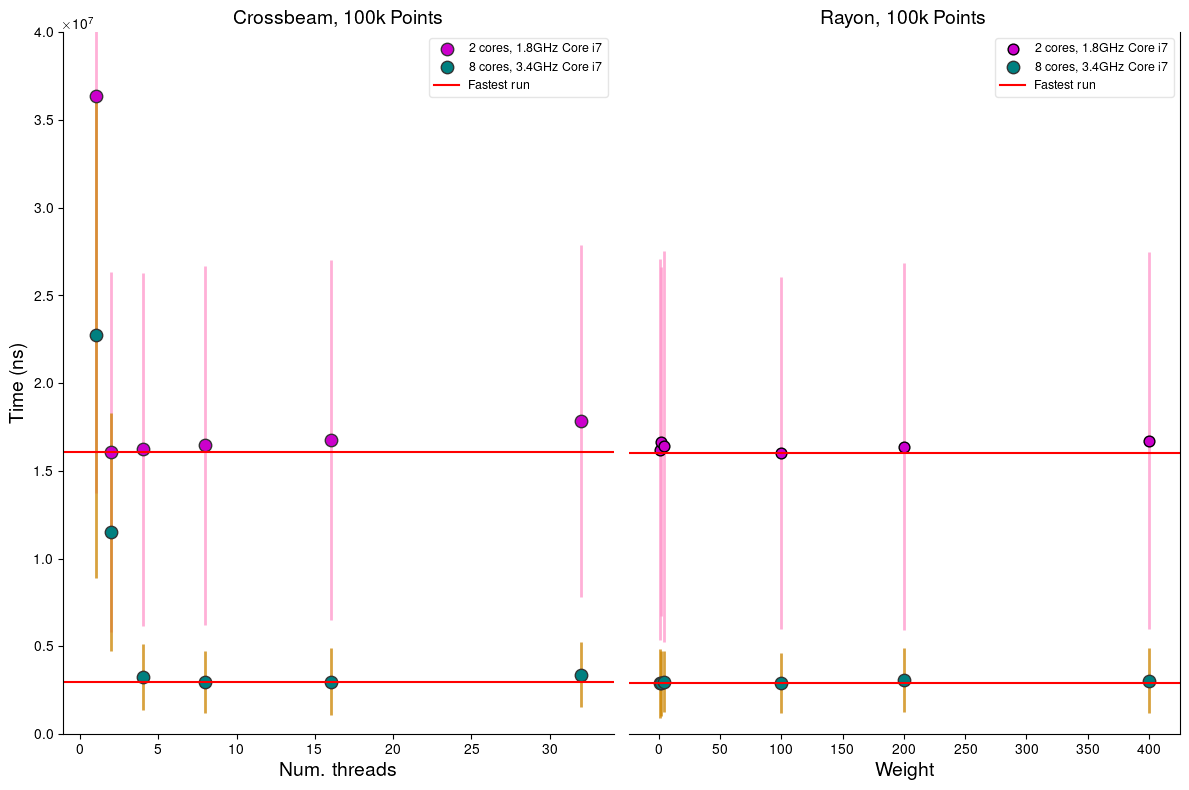A Rust library with FFI bindings for fast conversion between WGS84 longitude and latitude and British National Grid (epsg:27700) coordinates, using a Rust binary. Conversions use a standard 7-element Helmert transform with the addition of OSTN15 corrections for accuracy.
Python (etc.) is relatively slow; this type of conversion is usually carried out in bulk, so an order-of-magnitude improvement using FFI saves both time and energy.
Convertbng is an example Python Wheel which uses this binary via ctypes and cython.
Conversions which solely use Helmert transforms are accurate to within around 5 metres, and are not suitable for calculations or conversions used in e.g. surveying. Thus, we use the OSTN15 transform, which adjusts for local variation within the Terrestrial Reference Frame by incorporating OSTN15 data. See here for more information.
Add the following to your Cargo.toml (the latest version is displayed on the fourth badge at the top of this screen)
lonlat_bng = "x.x.x"
Full library documentation is available here
Note that lon, lat coordinates outside the UK bounding box will be transformed to (NAN, NAN), which cannot be mapped.
The functions exposed by the library can be found here
The FFI C-compatible functions exposed by the library are:
convert_to_bng_threaded(Array, Array) -> Array
convert_to_lonlat_threaded(Array, Array) -> Array
convert_to_osgb36_threaded(Array, Array) -> Array
convert_to_etrs89_threaded(Array, Array) -> Array)
convert_osgb36_to_ll_threaded(Array, Array) -> Array
convert_etrs89_to_ll_threaded(Array, Array) -> Array
convert_etrs89_to_osgb36_threaded(Array, Array) -> Array
convert_osgb36_to_etrs89_threaded(Array, Array) -> Array
convert_epsg3857_to_wgs84_threaded(Array, Array) -> Array
The library does not allocate memory using new vectors or arrays; the longitude and latitude arrays you pass to it via FFI are converted into mutable slices (an inherently unsafe operation), then mutated in-place before being passed back across the FFI boundary as C-compatible arrays. Thus, the calling code retains ownership of the allocated memory at all times – it is up to the calling program to ensure that the data passed to lonlat_bng live long enough, and are correctly freed (in practice, they will be freed automatically if using a dynamic language).
Running cargo build --release will build an artefact called liblonlat_bng.dylib on OSX, and liblonlat_bng.a on *nix systems. Note that you'll have to generate liblonlat_bng.so for *nix hosts using the following steps:
ar -x target/release/liblonlat_bng.agcc -shared *.o -o target/release/liblonlat_bng.so -lrt
convert_bng is available from PyPI for OSX, Windows, and *nix:
pip install convertbng
More information is available in its repository
A CProfile benchmark was run, comparing 50 runs of converting 1m random lon, lat pairs in NumPy arrays.
- 4 Amazon EC2 C4 (compute-optimised) systems were tested
- The system was first calibrated by taking the mean of five calibration runs of 100,000 repeats
- A benchmark program was then run for each of the three configurations. See the benches directory for details
- The five slowest function calls for each benchmark were then displayed.
| EC2 Instance Type | Processors (vCPU) | Rust Ctypes (s) | Rust Cython (s) | Pyproj (s) | Ctypes vs Pyproj | Cython vs Pyproj |
|---|---|---|---|---|---|---|
| c4.xlarge | 4 | 14.782 | 11.714 | 9.379 | 58.36% | 24.97% |
| c4.2xlarge | 8 | 8.647 | 6.421 | 9.256 | -6.57% | -30.62% |
| c4.4xlarge | 16 | 6.470 | 3.716 | 9.398 | -31.49% | -60.25% |
| c4.8xlarge | 36 | 4.913 | 2.501 | 9.308 | -48.05% | -73.35% |
Rust is faster than PROJ.4 on an 8-CPU system – even using ctypes – and outperforms it by greater margins as the number of CPUs increase: at 36 CPUs, Rust + Cython is over 3.7x faster.
Comparing how varying threads and weights affects overall speed, using cargo bench
On both 2- and 8-core i7 machines, running convert_bng_threaded_vec using one thread per core gives optimum performance, whereas Rayon does a good job at choosing its own optimum weight.
This software makes use of OSTN15 data, which is © Crown copyright, Ordnance Survey and the Ministry of Defence (MOD) 2016. All rights reserved. Provided under the BSD 2-clause license.



